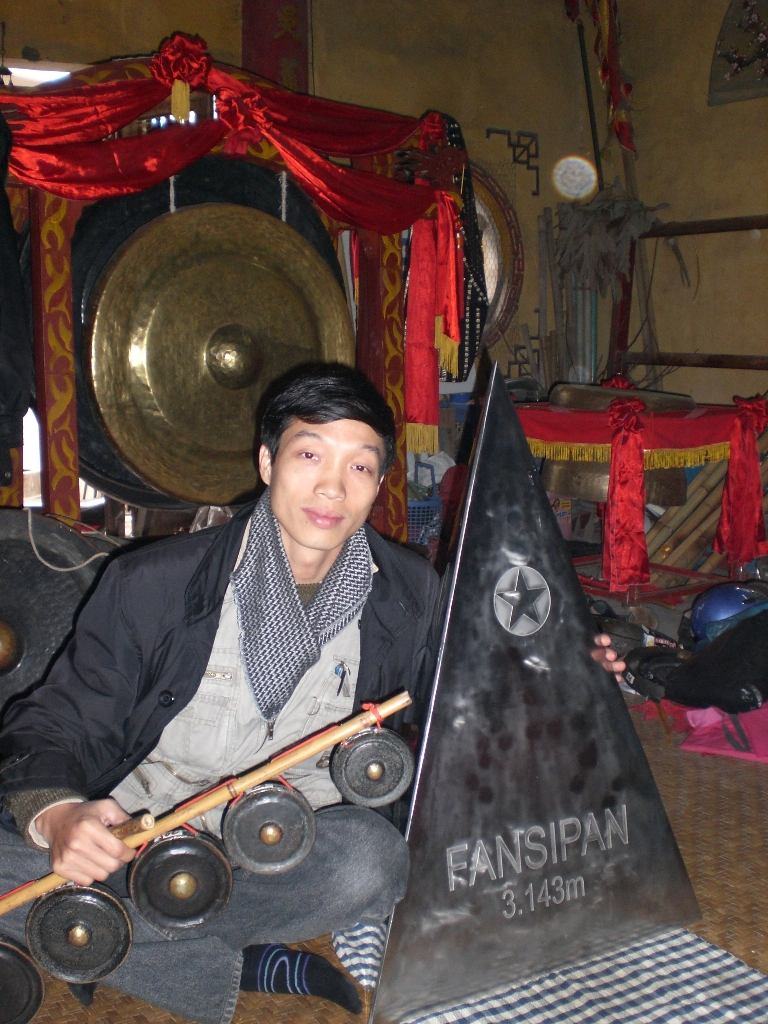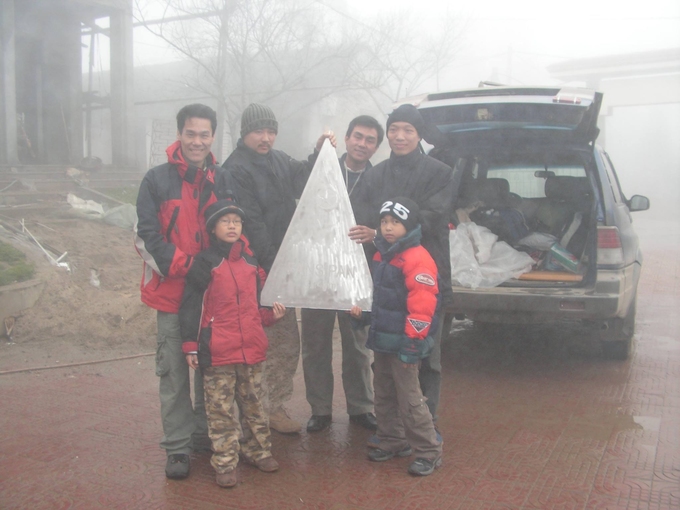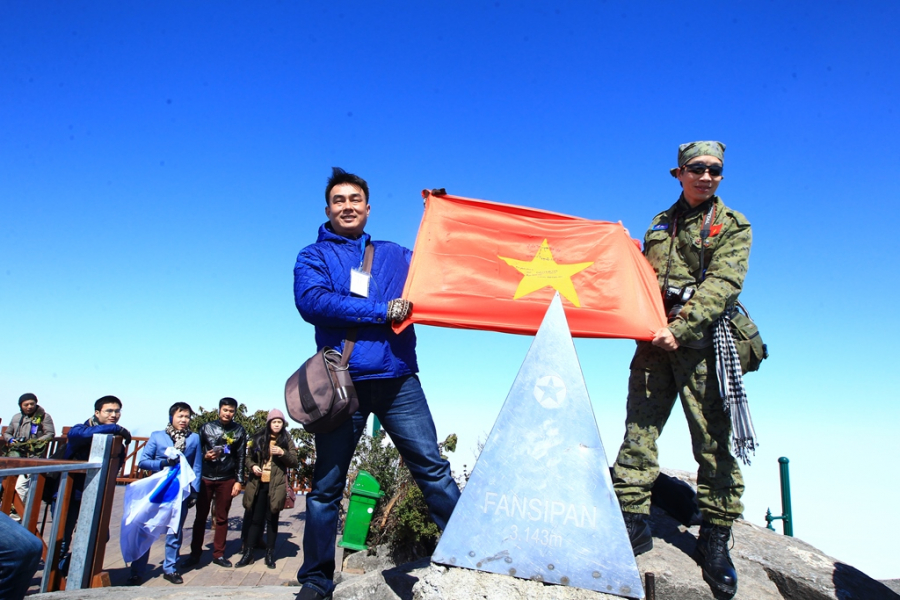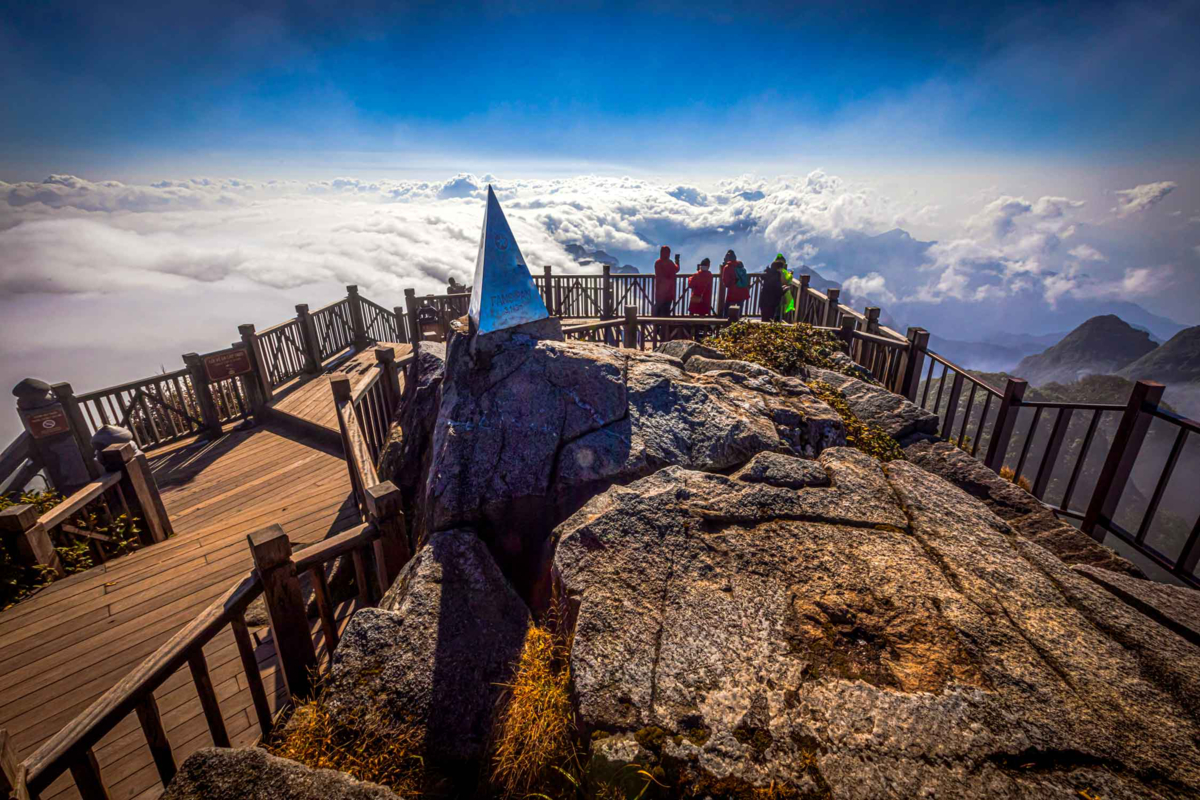Reuniting with his "brainchild" on the top of Fansipan on a day in May 2021, Mr. Le Hong Quang could not hide his emotion and pride in his eyes. Gently adjusting his five-panel ao dai in the strong winds on the mountain top, he slowly told about the idea of rebuilding a new peak for Fansipan, 13 years ago.

Mr. Le Hong Quang met his "brainchild" again on the top of Fansipan. Photo: Le Hong Quang
In early 2008, on the website Trai tim Viet Nam Online, one of the largest Vietnamese forums at that time, there were continuous posts warning about the damaged state of Fansipan peak. Although he had never seen it, the image of the granite block with its crisscrossing cracks still urged Hong Quang to restore the peak of the Roof of Indochina.
"At that time, I just thought that the milestone on the most difficult mountain to conquer in Vietnam had many sacred meanings," he recalled. Thinking and doing, on January 9, 2008, he posted a call to "Rebuild a new peak for Fansipan peak" on the forum. The topic received the attention and encouragement of many people. The group to build the peak had 4 new members: Ms. Le Thanh Van came up with the design drawings, Mr. Nguyen Minh Tuan was in charge of construction, Mr. Thanh Tung and Mr. Tan called for donations in the Tay Bac Group.
The next day, Mr. Quang sent a letter to the Director of Hoang Lien Son National Park (VQG), Mr. Nguyen Quoc Tri, asking for permission for the backpacker community and Fansipan lovers to build a summit in a communal manner. The group was empowered when Mr. Tri issued a written agreement. In less than a week, Mr. Quang's group called for donations of about 10 million VND and the group started construction.
Architect Thanh Van designed the first prototype of the spire in 1964. Initially, the material proposed for the spire was duralumin alloy because of its durability. However, this alloy was difficult to find and the group did not have enough funds. At that time, Mr. Nguyen Minh Tuan, a non-ferrous metallurgical engineer in the group, decided to use SUS201 stainless steel, with the commitment that "the spire will last over time, and when left on a high mountain top exposed to wind and rain, it will become more and more shiny".

The completed stainless steel top weighs more than 20 kg and is 99 cm high. Photo: Le Hong Quang
"Before making the top, I had once conquered Fansipan and noticed that the iron pillars here did not rust, due to the salty air, so the material I chose would help the top to be durable and beautiful," said Anh Tuan. After that, he was also the one who directly bought the materials, constructed and fed the letters on the stainless steel top.
On January 26, 2008, the cone was completed, weighing more than 20 kg and 99 cm high. On three sides of the cone are five-pointed stars with the wordsFansipan 3,143m, made of corrosive substances. On the same day, Mr. Quang brought the cone to Hoan Kiem Lake, in front of the statue of King Le Thai To to pray for peace, before getting on the car heading to Fansipan in the evening.
At midnight, the car taking the group to Yen Bai broke down. In order not to be late for the appointment to hand over the cone to the Hoang Lien Son National Park Management Board the next day, Hong Quang jumped on the train alone, holding the cone and heading towards Lao Cai. As soon as the train left the station, the car was repaired. Because of this incident, the group often joked that it was a "spiritual matter", because everyone who went to Lao Cai that day had to take the train, and the cone was no exception.
The next morning, the group met in Lao Cai and continued to Sa Pa town, handing over the summit to the National Park Management Board. To complete the plan before Tet, Mr. Nguyen Minh Tuan and some H'Mong porters carried the summit to the summit. Mr. Quang and the remaining members of the group did not accompany the group, because the journey to conquer Fansipan at that time required climbers to prepare physically in advance.

Mr. Quang's group handed over the crown to the Director of Hoang Lien Son National Park. Photo: Le Hong Quang
During winter days, the temperature in Hoang Lien Son can drop below 0 degrees Celsius, and the wind and rain can soak many layers of clothing, but that does not diminish the youthful energy and determination of the person carrying the peak. After two days of trekking through the forest, Tuan and the whole group reached the destination at noon on January 28, 2008. Due to the harsh weather, Tuan's whole body was stiff and he could not feel anything. A strong wind at that time seemed like it could pull him down the cliff.

The stainless steel spire stands tall on the Roof of Indochina. Photo: Internet
In half an hour, he urgently drilled the rock, poured cement, and fixed the top to get down the mountain as soon as possible. However, each step was carried out meticulously, so that the sharp corner of the top faced north and the flat surface faced south, so that on clear days, the sunlight would reflect brightly on the mountain top.
As soon as he reached the summit, Mr. Tuan felt like he was drained of all his strength, and he returned about 100 meters down the summit. His whole body was cramped, his thin shirt was soaked, causing his body to lose heat quickly, forcing him to lie down on the side of the road. At that time, the porter team continuously urged and encouraged him to quickly regain his strength and return to the campsite to warm up before his health condition worsened.

The "founders" of Fansipan peak took a photo to commemorate their reunion. Photo: Le Hong Quang
On February 17th of that year, which also happened to be his 35th birthday, Mr. Hong Quang and the "Fansipan Love - Fanlove" group of 34 members, who were also donors, conquered the high mountain.
More than 10 years have passed, but Mr. Quang and Mr. Tuan still cannot forget the feeling of the cold penetrating their skin and the frozen leaves in the Hoang Lien Son forest that day. But what they remember most is probably the pride and love for their country that filled their chests, when standing next to their "brainchild" on the Roof of Indochina.


































